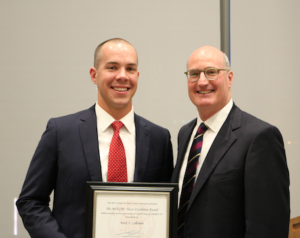Mark Callahan ’17 Receives MIT CRE Thesis Excellence Award
Monday, July 31, 2017
Samberg Conference Center, MIT
The MIT Center for Real Estate Thesis Excellence Award
The MIT Center for Real Estate Thesis Excellence Award is presented to the student who has prepared a thesis which is recognized as achieving a level of excellence above and beyond the high standards of MIT. Creativity and originality are considered as well as analysis, execution, and presentation of the final thesis product.
This award has been made possible through the generous sponsorship of MSRED alumnus David Deutsch ’93. Mr. Deutsch currently serves as Senior Portfolio Manager at ICG Alternative Credit in New York City.
This year’s Thesis Excellence Award has been presented to Mark F. Callahan MSRED ’17. Mark was the 2017 Cultivating Leadership in Real Estate Prologis Fellow.

Thesis
Using Transactional and Spatial Data to Determine Drivers of Industrial Land Value
Abstract
The value of a given parcel of land is determined by a multitude of factors based on its location and physical characteristics. No two parcels are alike, making direct comparison between parcels and the study of underlying land values difficult. Further, in locations where land is most valuable, there are often existing improvements on the land. In order to determine a land-only value, the value of the existing buildings or infrastructure must be estimated. This leads to the potential for errors and other issues. There has been a great deal of research conducted on land value for specific real estate uses, such as residential or office. However, little research has been conducted on industrial land.
This study will focus specifically on industrial land value and the individual factors that drive it. This study analyzes a database of 1,000 transactions in 10 of the largest industrial real estate markets in the United States. The data set is unique because most of the data points are land only, lessening the impact of appraisal and estimation techniques. Additional variables were added to each data point to account for local land use regulation, as well as spatial location. A regression analysis determined how these variables influenced the underlying land values. From this analysis, the following conclusions emerged: First, land use regulation is a strong driver of industrial land values. Using index values from the Wharton Residential Land Use Regulatory Index (WRLURI), the analysis showed that land values increased when the stringency of land regulation increased. Second, proximity to interstate highways, airports, and the central business district are also significant drivers of industrial land value. Decreased distances to these points of interest resulted in increased land value. Third, industrial land values are also positively influenced by the cumulative income of the surrounding population. A 1 percent increase in cumulative population income resulted in an approximately 0.47 percent increase in land value. Lastly, physical land features impacted land values intuitively. Flattened, developed sites were much more valuable than raw, undeveloped sites.
For more information about Fellowships, Scholarships, and Awards, please click here.
